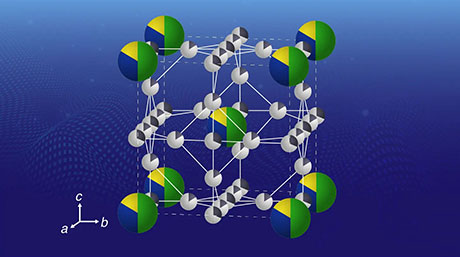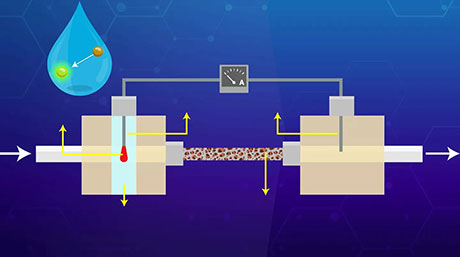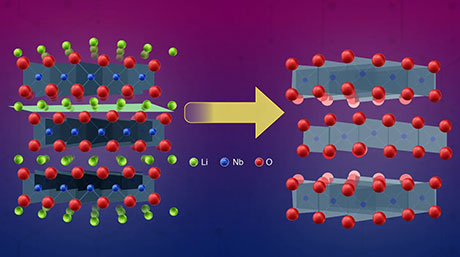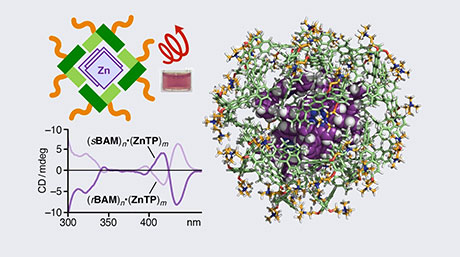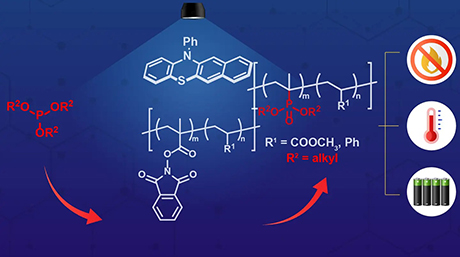Chemical Science and Engineering News
Simultaneous Synthesis and Fixing of Covalent Organic Frameworks
An electrogenerated acid can catalyze the synthesis and simultaneous immobilization of imine-based covalent organic frameworks (COFs) onto electrodes, report scientists from Tokyo Tech. Starting with amine and aldehyde monomers, they obtained corresponding COF films, including three-dimensional ones, with high crystallinity, porosity, and controlled thickness. This could facilitate the synthesis of COFs with applications in functional electrodes and sensing materials.
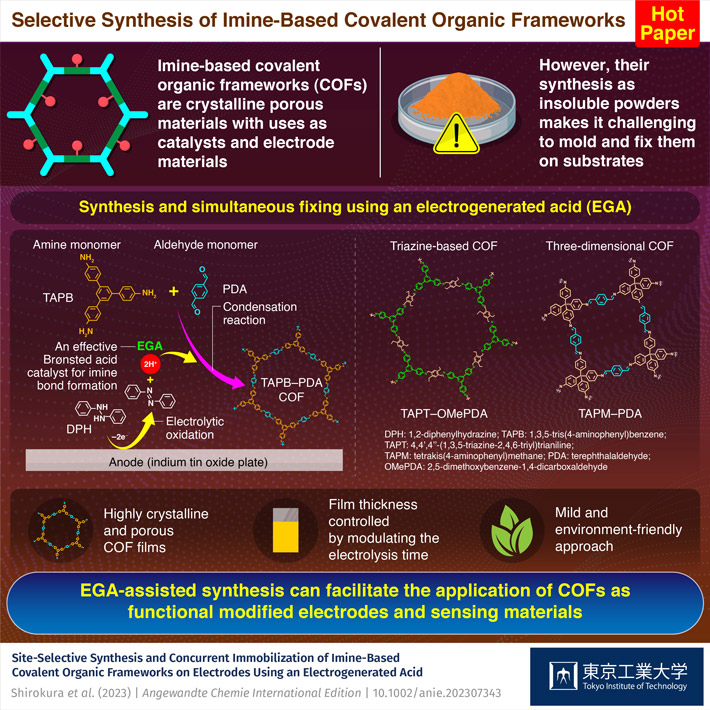
Covalent organic frameworks (COFs) are versatile materials composed of interconnected organic molecules held together by covalent bonds. These frameworks can be constructed in two-dimensional or three-dimensional (3D) forms which possess a unique combination of low density, high surface area, and easily tunable properties. Among the various types of COFs, imine-linked COFs have garnered considerable attention owing to their exceptional thermal and chemical stability as well as their broad scope of monomeric starting materials.
However, traditional bulk synthetic methods for COFs often yield powders that are insoluble in common organic solvents, posing challenges during their subsequent molding and fixing on substrates. While alternative fabrication approaches, such as exfoliation of bulk COFs into nanosheets, employment of novel interfaces, and use of templates for freestanding films, overcome this limitation, they usually involve multiple steps and produce low-quality COF structures.
Recently, a team of researchers from Japan, led by Professor Shinsuke Inagi from Tokyo Institute of Technology (Tokyo Tech), has developed a novel method for synthesizing and fixing high-quality imine-based COFs. Their work was made available online on 9 June 2023 and published as "Hot Paper" in the Angewandte Chemie International Edition journal![]() .
.
"The proposed method utilizes an electrogenerated acid (EGA), produced via electrochemical oxidation of 1,2-diphenylhydrazine (DPH) in an organic electrolytic solution, as a catalyst for COF synthesis and immobilization onto electrode surfaces. It acts as a strong Brønsted acid, promoting the condensation reaction between amine and aldehyde monomers—the building blocks of imine-based COFs—to form covalent bond networks," explains Prof. Inagi.
The team chose DPH as the EGA source due to its low oxidation potential and acid-releasing properties and used 1,3,5-tris (4-aminophenyl) benzene (TAPB) and terephthalaldehyde (PDA). By employing the potential-sweep method for electrolysis, they successfully obtained film-like COF deposits on indium tin oxide electrodes immersed in nitromethane. The TAPB–PDA COF films possessed high crystallinity and porosity. In addition, their thickness could be controlled by modulating the electrolysis time.
The researchers also extended their electrochemistry-based approach to the synthesis of other structures, including triazine-based and 3D COFs.
In conclusion, Prof. Inagi highlights the future potential of the proposed method. "It eliminates the need for long reaction times, high temperatures, and Lewis acid catalysts typically required in conventional COF synthesis, making it environment friendly," he highlights. "Moreover, the direct fixing of COF films onto electrodes is promising for COF-based applications, especially in functional modified electrodes and sensing materials."
We certainly hope that this innovative and sustainable synthesis approach will lead to many more novel functional materials!
- Reference
| Authors : | Tomoki Shirokura1, Tomoki Hirohata1, Kosuke Sato1, Elena Villani1, Kazuyasu Sekiya2, Yu-An Chien3, Tomoyuki Kurioka3, Ryoyu Hifumi1, Yoshiyuki Hattori2, Masato Sone3, Ikuyoshi Tomita1, and Shinsuke Inagi1,* |
|---|---|
| Title : | Site-Selective Synthesis and Concurrent Immobilization of Imine-Based Covalent Organic Frameworks on Electrodes Using an Electrogenerated Acid |
| Journal : | Angewandte Chemie International Edition |
| DOI : | 10.1002/anie.202307343 |
| Affiliations : | 1Department of Chemical Science and Engineering, Tokyo Institute of Technology 2Faculty of Textile Science and Technology, Shinshu University 3Institute of Innovative Research, Tokyo Institute of Technology |
|
* Corresponding author's email: inagi@cap.mac.titech.ac.jp |
|
- Electrochemical Synthesis Now Possible Without Electric Power Source | Tokyo Tech News
- Bipolar Order: A Straightforward Technique to Have More Control Over Organic Thin Films | Tokyo Tech News
- Shinsuke Inagi and Masaaki Kitano are FY2018 STAR grant recipients | Tokyo Tech News
- Eight Tokyo Tech faculty members receive 2016 MEXT Young Scientists' Prize | Tokyo Tech News
- Inagi Laboratory
- Shinsuke Inagi | Researcher Finder - Tokyo Tech STAR Search
- Energy Science and Engineering Graduate Major|Education|Department of Chemical Science and Engineering, School of Materials and Chemical Technology
- Chemical Science and Engineering Graduate Major|Education|Department of Chemical Science and Engineering, School of Materials and Chemical Technology
- Chemical Science and Engineering Undergraduate Major|Education|Department of Chemical Science and Engineering, School of Materials and Chemical Technology
- Latest Research News
School of Materials and Chemical Technology
—Encompassing the Disciplines of Science—
Information on School of Materials and Chemical Technology inaugurated in April 2016
Further Information
Professor Shinsuke Inagi
School of Materials and Chemical Technology,
Tokyo Institute of Technology

